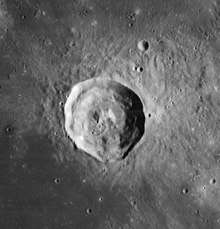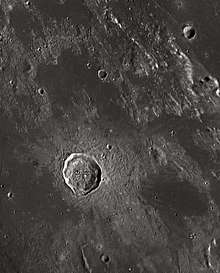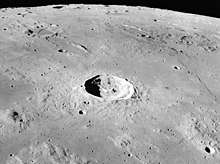Manilius (crater)
Manilius is a lunar impact crater on the northeast edge of Mare Vaporum. Its diameter is 38 km.[1]
 Lunar Orbiter 4 image | |
| Coordinates | 14.5°N 9.1°E |
|---|---|
| Diameter | 38 km (24 mi) |
| Depth | 3.05 km (10,000 ft) |
| Colongitude | 351° at sunrise |
| Eponym | Marcus Manilius |
Description
Manilius has a well-defined rim with a sloping inner surface that runs directly down to the ring-shaped mound of scree along the base, and a small outer rampart. The small crater interior has a higher albedo than the surroundings, and it appears bright when the sun is overhead. Within the crater is a central peak formation near the midpoint.
The crater also possesses a ray system that extends for a distance of over 300 kilometers. Despite the presence of these rays, which generally indicate the age of the crater as Copernican, the crater is currently mapped as Eratosthenian age.[2]
Names
Manilius is named after the Roman astronomer Marcus Manilius.[1] Like many of the craters on the Moon's near side, it was given its name by Giovanni Riccioli, whose 1651 nomenclature system has become standardized.[3] Earlier lunar cartographers had given the feature different names. Michael van Langren's 1645 map calls it "Isabellae Reg. Hisp." (Isabella, Queen of Spain),[4] and Johannes Hevelius called it "Insula Besbicus" after the island in Turkey now known as İmralı.[5]
Satellite craters

By convention these features are identified on lunar maps by placing the letter on the side of the crater midpoint that is closest to Manilius.


| Manilius | Latitude | Longitude | Diameter |
|---|---|---|---|
| B | 16.6° N | 7.3° E | 6 km |
| C | 12.1° N | 10.4° E | 7 km |
| D | 13.2° N | 7.0° E | 5 km |
| E | 18.3° N | 6.4° E | 49 km |
| G | 15.5° N | 9.7° E | 5 km |
| H | 17.8° N | 8.6° E | 3 km |
| K | 11.9° N | 11.2° E | 3 km |
| T | 13.4° N | 10.6° E | 4 km |
| U | 13.8° N | 10.8° E | 4 km |
| W | 13.4° N | 12.9° E | 4 km |
| X | 14.4° N | 13.4° E | 3 km |
| Z | 16.4° N | 11.7° E | 3 km |
 Oblique view of Manilius G, northeast of Manilius
Oblique view of Manilius G, northeast of Manilius
The following craters have been renamed by the IAU.
References
- "Manilius (crater)". Gazetteer of Planetary Nomenclature. USGS Astrogeology Research Program.
- Stratigraphy of Lunar Craters, Don E. Wilhelms and Charles J. Byrne, January 23, 2009
- Ewen A. Whitaker, Mapping and Naming the Moon (Cambridge University Press, 1999), p.61.
- Ewen A. Whitaker, Mapping and Naming the Moon (Cambridge University Press, 1999), p. 198.
- Ewen A. Whitaker, Mapping and Naming the Moon (Cambridge University Press, 1999), p. 202.
- Andersson, L. E.; Whitaker, E. A. (1982). NASA Catalogue of Lunar Nomenclature. NASA RP-1097.CS1 maint: ref=harv (link)
- Bussey, B.; Spudis, P. (2004). The Clementine Atlas of the Moon. New York: Cambridge University Press. ISBN 978-0-521-81528-4.CS1 maint: ref=harv (link)
- Cocks, Elijah E.; Cocks, Josiah C. (1995). Who's Who on the Moon: A Biographical Dictionary of Lunar Nomenclature. Tudor Publishers. ISBN 978-0-936389-27-1.CS1 maint: ref=harv (link)
- McDowell, Jonathan (July 15, 2007). "Lunar Nomenclature". Jonathan's Space Report. Retrieved 2007-10-24.CS1 maint: ref=harv (link)
- Menzel, D. H.; Minnaert, M.; Levin, B.; Dollfus, A.; Bell, B. (1971). "Report on Lunar Nomenclature by the Working Group of Commission 17 of the IAU". Space Science Reviews. 12 (2): 136–186. Bibcode:1971SSRv...12..136M. doi:10.1007/BF00171763.CS1 maint: ref=harv (link)
- Moore, Patrick (2001). On the Moon. Sterling Publishing Co. ISBN 978-0-304-35469-6.CS1 maint: ref=harv (link)
- Price, Fred W. (1988). The Moon Observer's Handbook. Cambridge University Press. ISBN 978-0-521-33500-3.CS1 maint: ref=harv (link)
- Rükl, Antonín (1990). Atlas of the Moon. Kalmbach Books. ISBN 978-0-913135-17-4.CS1 maint: ref=harv (link)
- Webb, Rev. T. W. (1962). Celestial Objects for Common Telescopes (6th revised ed.). Dover. ISBN 978-0-486-20917-3.CS1 maint: ref=harv (link)
- Whitaker, Ewen A. (1999). Mapping and Naming the Moon. Cambridge University Press. ISBN 978-0-521-62248-6.CS1 maint: ref=harv (link)
- Wlasuk, Peter T. (2000). Observing the Moon. Springer. ISBN 978-1-85233-193-1.CS1 maint: ref=harv (link)
External links
| Wikimedia Commons has media related to Manilius (crater). |
- Manilius at The Moon Wiki
- Wood, Chuck (December 4, 2005). "A Line of Domes". Lunar Photo of the Day. Archived from the original on May 14, 2006. Retrieved 2006-07-21.
- Wood, Chuck (September 8, 2007). "Rare Image of a Common Crater". Lunar Photo of the Day. Archived from the original on June 30, 2015. Retrieved 2007-09-10.